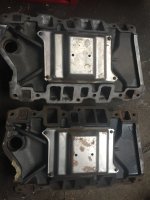Last Wednesday I dewinterized my boat, a 2001 Mercruiser 4.3 EFI. It turned into a bad day!
Below are notes I made afterward while it was still fresh in my head....
- I hooked up water.
- The engine started quickly.
- After a couple minutes water started coming out the back of the boat (normally).
- Kept an eye on the gauges, the temperature gauge never rose.
- I felt the water coming out the back, it was very hot.
- The engine started running rough.
- I shut the motor off, I noticed some popping noise from engine.
- Let it sit for about 20 minutes.
- Restarted the engine, it ran rough, gave gas, smoothed out.
- Got rough again, noticed water spurting out of the oil dip stick.
- Shut off immediately.
- Bummed out….
End of Notes
The next day I checked the oil level on the dip stick, it was a milky color and ¾ up the stick...
Today I removed the intake manifold and it's cracked. I've owned this boat for 20 years now, and have always winterized it the same way. I drain the water, poke a wire in the drain hole, and using a plastic tube, vacuum out the hole. I guess some water did not drain.
I visually checked the heads after removing the intake, and from what I can see they look ok. Using a socket and breaker bar, I was able to turn the crank over to bring it to top dead center before removing the distributor. Other than compression, it turned easy enough. I started draining the milky oil today, which is going very slow and may be drained by Thanksgiving. If the temp gauge was working
I would appreciate some opinions -
Basically what am I'm dealing with at this point?
I would have shut it down a lot sooner if the temperature gauge was working. Was the gauge not working because of the cracked head, or was that coincidental?
Should I pull each spark plug and check them?
Could there be more damage than I'm aware of?
Is there any way to speed up draining the milky oil, short of pulling the oil pan, which is next to impossible.
Can I upgrade the manifold for better performance?
Here's a few pictures of the crack. One thing of interest are the scratch marks on the crack, which had to be there since it was new. I doubt it had anything to do with the crack after 20 years though.
Thanks



Below are notes I made afterward while it was still fresh in my head....
- I hooked up water.
- The engine started quickly.
- After a couple minutes water started coming out the back of the boat (normally).
- Kept an eye on the gauges, the temperature gauge never rose.
- I felt the water coming out the back, it was very hot.
- The engine started running rough.
- I shut the motor off, I noticed some popping noise from engine.
- Let it sit for about 20 minutes.
- Restarted the engine, it ran rough, gave gas, smoothed out.
- Got rough again, noticed water spurting out of the oil dip stick.
- Shut off immediately.
- Bummed out….
End of Notes
The next day I checked the oil level on the dip stick, it was a milky color and ¾ up the stick...
Today I removed the intake manifold and it's cracked. I've owned this boat for 20 years now, and have always winterized it the same way. I drain the water, poke a wire in the drain hole, and using a plastic tube, vacuum out the hole. I guess some water did not drain.
I visually checked the heads after removing the intake, and from what I can see they look ok. Using a socket and breaker bar, I was able to turn the crank over to bring it to top dead center before removing the distributor. Other than compression, it turned easy enough. I started draining the milky oil today, which is going very slow and may be drained by Thanksgiving. If the temp gauge was working
I would appreciate some opinions -
Basically what am I'm dealing with at this point?
I would have shut it down a lot sooner if the temperature gauge was working. Was the gauge not working because of the cracked head, or was that coincidental?
Should I pull each spark plug and check them?
Could there be more damage than I'm aware of?
Is there any way to speed up draining the milky oil, short of pulling the oil pan, which is next to impossible.
Can I upgrade the manifold for better performance?
Here's a few pictures of the crack. One thing of interest are the scratch marks on the crack, which had to be there since it was new. I doubt it had anything to do with the crack after 20 years though.
Thanks
































